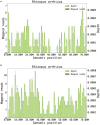Rhino-Orbital Cerebral Mucormycosis in a Patient With Diabetic Ketoacidosis: A Case Report and Literature Review
- PMID: 35599740
- PMCID: PMC9114505
- DOI: 10.3389/fneur.2022.815902
Rhino-Orbital Cerebral Mucormycosis in a Patient With Diabetic Ketoacidosis: A Case Report and Literature Review
Abstract
Background: Rhino-orbital cerebral mucormycosis (ROCM) is a rare, invasive, and fatal fungal disease. Due to the lack of specific clinical manifestations and adequate auxiliary examinations, patients are easily misdiagnosed in the early stage. Early diagnosis and timely therapy are essential for successful treatment.
Case report: We report a 68-year-old man with diabetic ketoacidosis, presented with orbital apex syndrome (OAS), fever, and pansinusitis, which progressively worsened to death only 4 days after admission. It was finally confirmed as a fungal Rhizopus arrhizus infection by metagenomics cell-free DNA next-generation sequencing (mNGS) testing.
Conclusion: Orbital apex syndrome could be the initial presentation for mucormycosis. Thus, it is necessary to evaluate the presence of mucormycosis in patients with OAS, especially in diabetic or immunosuppressed hosts, and mNGS testing and timely antifungal therapy should be strongly recommended in highly suspected cases.
Keywords: diabetes; ketoacidosis; metagenomics cell-free DNA next-generation sequencing; orbital apex syndrome; rhino-orbital cerebral mucormycosis.
Copyright © 2022 Dong, Jordan, Shen, Wu, Guo, Zhao, Wang, Wang and Fang.
Conflict of interest statement
YW was employed by Genoxor Medical Science and Technology Inc. The remaining authors declare that the research was conducted in the absence of any commercial or financial relationships that could be construed as a potential conflict of interest.
Figures


Similar articles
-
Rhino-orbital-cerebral mucormycosis caused by Rhizopus arrhizus diagnosis via metagenomics next-generation sequencing: a case report.Front Cell Infect Microbiol. 2024 Jul 16;14:1375058. doi: 10.3389/fcimb.2024.1375058. eCollection 2024. Front Cell Infect Microbiol. 2024. PMID: 39081868 Free PMC article.
-
A retrospective analysis of eleven cases of invasive rhino-orbito-cerebral mucormycosis presented with orbital apex syndrome initially.BMC Ophthalmol. 2016 Jan 12;16:10. doi: 10.1186/s12886-016-0189-1. BMC Ophthalmol. 2016. PMID: 26758904 Free PMC article.
-
Diabetic ketoacidosis and coronavirus disease 2019-associated mucormycosis: a case report.J Med Case Rep. 2022 Oct 31;16(1):400. doi: 10.1186/s13256-022-03594-2. J Med Case Rep. 2022. PMID: 36316719 Free PMC article.
-
Managing mucormycosis in diabetic patients: A case report with critical review of the literature.Oral Dis. 2022 Apr;28(3):568-576. doi: 10.1111/odi.13802. Epub 2021 Mar 2. Oral Dis. 2022. PMID: 33583133 Review.
-
COVID-19-associated rhino-orbital-cerebral mucormycosis: A systematic review, meta-analysis, and meta-regression analysis.Indian J Pharmacol. 2021 Nov-Dec;53(6):499-510. doi: 10.4103/ijp.ijp_839_21. Indian J Pharmacol. 2021. PMID: 34975140 Free PMC article.
Cited by
-
Nasal and cutaneous mucormycosis in two patients with lymphoma after chemotherapy and target therapy: Early detection by metagenomic next-generation sequencing.Front Cell Infect Microbiol. 2022 Sep 16;12:960766. doi: 10.3389/fcimb.2022.960766. eCollection 2022. Front Cell Infect Microbiol. 2022. PMID: 36189372 Free PMC article.
-
Rhino-Orbital Mucormycosis Presenting As Orbital Apex Syndrome With Central Retinal Artery Occlusion: A Rare Phenomenon.Cureus. 2024 Nov 10;16(11):e73400. doi: 10.7759/cureus.73400. eCollection 2024 Nov. Cureus. 2024. PMID: 39659354 Free PMC article.
-
Invasive Fungal Infections in Immunocompromised Conditions: Emphasis on COVID-19.Curr Microbiol. 2024 Oct 9;81(11):400. doi: 10.1007/s00284-024-03916-1. Curr Microbiol. 2024. PMID: 39384659 Review.
-
Rhino-orbital-cerebral mucormycosis caused by Rhizopus arrhizus diagnosis via metagenomics next-generation sequencing: a case report.Front Cell Infect Microbiol. 2024 Jul 16;14:1375058. doi: 10.3389/fcimb.2024.1375058. eCollection 2024. Front Cell Infect Microbiol. 2024. PMID: 39081868 Free PMC article.
-
Mucor indicus caused disseminated infection diagnosed by metagenomic next-generation sequencing in an acute myeloid leukemia patient: A case report.Front Cell Infect Microbiol. 2023 Feb 7;13:1089196. doi: 10.3389/fcimb.2023.1089196. eCollection 2023. Front Cell Infect Microbiol. 2023. PMID: 36824686 Free PMC article.
References
Publication types
LinkOut - more resources
Full Text Sources
Miscellaneous

